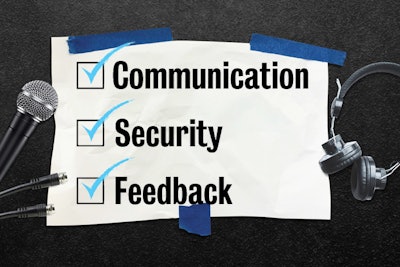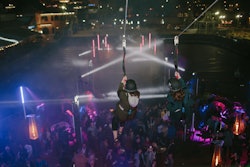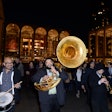
To position your event to be as successful as possible, treating talent properly is essential. Here are nine tips for fostering the best possible relationship with performers and entertainers.
1. Communicate clearly.
Communication is the most important element of a successful collaboration with talent. Details from dress code to equipment loading to what meals will be provided should be identified in writing. “In the contract, most of the time the artists will set specifics that they want, like the setup requirements, AV needs, what expenses will be paid for, how many people will be performing, the lighting, how they want the stage, details about the green room,” says Maribel Ramirez, president of Miami-based Cor-events.
Artists often provide riders that lay out these requests in minute detail, from the type of microphone they require to their preferred temperature of drinking water. While these niceties may seem trivial, they can reveal if a planner is paying attention. Planners should read riders thoroughly, and if a request isn’t feasible, be upfront and honest about it. “People are much more lenient about adjusting the rider than they were in the past,” says Rob Jockel, owner and general manager at Cutting Edge Entertainment in Avon, Connecticut. “Artists know the drill. A lot of it is just about treating them with respect.”
2. Make talent feel welcome.
Just like your guests want to feel welcome, so do your entertainers. “A really good event planner understands that if you take good care of your talent, your event is going to be so much better,” says Mary Marchetti, owner at Backstage Bistro VIP Catering & Events in Northern Virginia. Keep in mind that performers might be exhausted from traveling, especially if they’re in the middle of a tour, and think about what you can do to make them as comfortable as possible.
“Providing some food, even if it’s just light refreshments, makes a really huge difference,” says Yulia Gavriltseva, project manager at Creativiva in Toronto. “Taking that extra step makes an artist feel welcomed, and they’ll give back with their performance.” This added level of hospitality can begin even before the artist arrives on site. If they’re coming via car service, for instance, have water, snacks and/or a welcome gift waiting in the car. But before stocking up, be sure to confirm if there are any allergies or dietary restrictions about which you should be aware.
To go the extra mile, find out what foods, drinks, scents, flowers, and other details they might appreciate. Marchetti also suggests being prepared with a “survival kit” of last-minute items that a performer might need, which could range from water to mints to easy-to-eat snacks.
3. Make safety a priority.
An entertainer’s safety is a top priority. For instance, if a performance involves a trapeze, rigging, or any other element that needs to be inspected for safety, planners should personally verify that everything is up to code. “Don’t get complacent and assume that the people setting things up are doing it right,” says Makinlee Fox, logistics manager at Albrecht Events near Philadelphia. “You rely on your AV team for their expertise, but you still want to ask the questions that help you determine that it’s safe.” Make sure that all wires are taped down properly, speakers are secured, and any obstacles that could lead to injury are identified and corrected.
4. Respect their privacy.
It’s important to respect an artist’s privacy, especially if that person is a celebrity. Assure performers that their belongings are secure in the green room, their personal information will not be shared, riders won’t be leaked, and privacy will be maintained. “Artists can be very exposed on the road, and we let them know that we aren’t going to share their personal info with the universe,” says Marchetti.
5. Share important event details.
Knowing key details about the event, including the client’s industry, demographics of the audience, dress code, and type of event helps artists give the best show possible. “We express the goal of the performance to the talent so that they can meet and exceed the client’s expectations,” says Jennie Tis, director of business development at Roberts Event Group, a Hosts Global Member, located near Philadelphia. Sending information like a site map, agenda, and schedule helps talent maximize their performances. An artist might use a different approach for a room full of doctors as opposed to a group of startup entrepreneurs, for example. “The more information you give performers, the better they will be,” adds Fox. “At the end of the day, they want you and your client to be happy.”
6. Take care of the whole crew.
A performance almost always involves more than just the people appearing on stage. From sound engineers to managers to bus drivers, it takes a team to create a large-scale performance. And just like the talent needs to be fed and cared for, so does the crew. “If anyone on the team is unhappy, it affects the end result of the performance,” says Marchetti. “I know that if the first truck driver comes in at 4 a.m. and can get fresh, hot coffee or something delicious to eat, it sets the right tone for everything else that will happen that day.”
7. Have a designated point of contact.
Talent should have a single point of contact from your team on the day of the event. In addition to greeting the entertainers and keeping everyone on schedule, this contact will be the performers’ go-to person for any issues that arise. “The artist liaison should know what the performers need and make sure that they have it when they arrive,” says Fox. The point person should be aware of all of the contract riders and requirements, then review them on site to make sure they are met. Gavriltseva advises giving the artist the contact’s mobile phone number. “Sometimes when you’ve been communicating over email, the performer doesn’t realize that they don’t have a contact phone number until the day of the event,” she explains. “It seems like basic logic, but sometimes people forget about it.”
8. Be upfront about the payment schedule.
Artists, of course, prefer to be paid on site on the day of the event, but doing so is not always possible. Jockel suggests paying artists as promptly as possible and being open about the payment schedule. “If it takes a corporate client 30 to 45 days to write a check, make sure you communicate that to the talent,” he explains. Such issues should be hashed out beforehand, ideally before the contract is signed. “You don’t want an artist to be upset or have an attitude. You want them to be happy and get everyone excited.”
9. Give post-event appreciation and feedback.
The collaboration doesn’t end with the event. To build a long-term relationship, communicate with the artist and his/her team after the event, especially if you’d like to work together again. “After the performance, if it was well received, we send a thank-you note for a job well done,” says Ramirez. And if the performance wasn’t successful, the performer should know that as well. Sharing what went right or wrong can help entertainers improve for their next gig—whether it’s with you or another client.
A version of this story appeared in the Winter 2018 issue of BizBash.



















